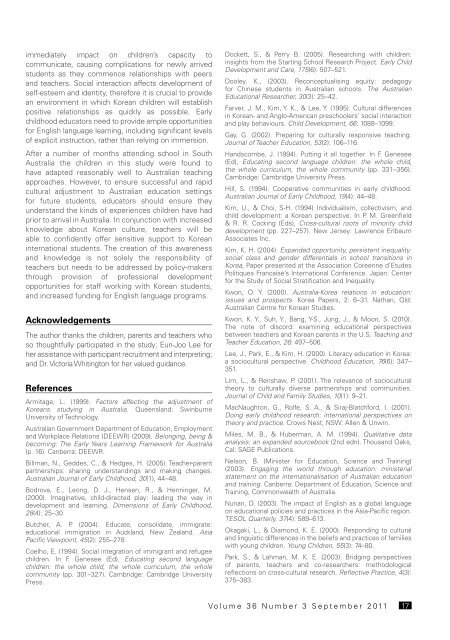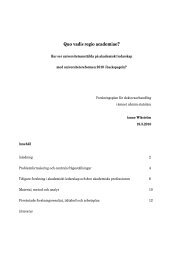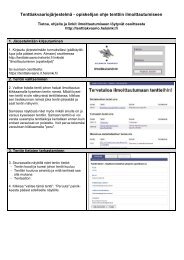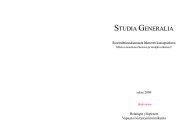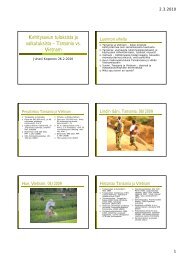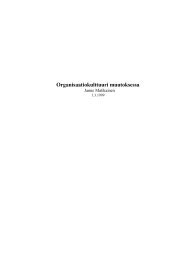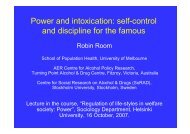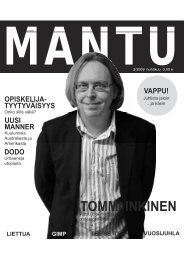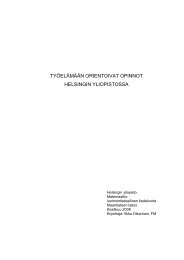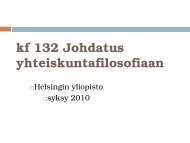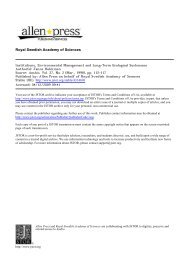During their interviews all four teachers revealed gapsin their knowledge about the Korean children and theirfamilies’ circumstances. Three teachers were unawarethat the children were living in Australia with only theirmothers and siblings. There was also an apparentmismatch between teachers’ perceptions and mothers’perceptions about the English language abilities <strong>of</strong> newKorean students. In all cases the teachers reportedthat the children came to Australia with ‘no English’,though two children had received intensive privateEnglish tuition for nearly six months before arrival.These findings indicated that some educators need tobecome better informed about the educational context<strong>of</strong> the international students in their classes (Gay, 2002;Kwon et al., 2010). Deeper understanding would alsoreinforce development <strong>of</strong> stronger teacher–parentrelationships (DEEWR, 2009; Handscombe, 1994).Educational and cultural experiencesJae Hoon’s experience shows the importance <strong>of</strong>international students’ accessibility to other studentsfrom the same country. Only after the teacher introducedhim to other Korean students did Jae Hoon begin todisplay signs <strong>of</strong> cultural adjustment. Consistent withSonderegger & Barrett (2004), his anxiety decreasedonce he formed relationships with these students.The two children who had received intensive Englishtuition in Korea were reported as showing signs <strong>of</strong>quicker cultural adjustment. However, that thesewere the two eldest children may be relevant. Allfour children’s self-description indicated that duringthe early weeks at school in Australia they had poorself-esteem regarding English language skills andexperienced varying levels <strong>of</strong> anxiety. The mothers andteachers said the children’s process <strong>of</strong> acculturationwas ameliorated by social support from peers andteachers (Sonderegger & Barrett, 2004).Serendipitous findings involved the needs <strong>of</strong> the mothers.The families in this study had no contacts in Australia priorto arrival and needed to generate new social networks.Problems <strong>of</strong> social isolation were significant, particularlyfor one mother who arrived with no English skills.RecommendationsIn this study, three teachers expressed frustration atwhat they perceived to be limited language supportfor the Korean students in their classes. Since Englishlanguage difficulties are a barrier to cultural adjustment,the children may benefit from an initial intensivelanguage course similar to the New Arrivals programs.Korean students’ mothers may also benefit fromaccess to language support.Teachers voiced concern about lack <strong>of</strong> teacherpr<strong>of</strong>essional development regarding internationalstudents. Pr<strong>of</strong>essional development opportunitieswhich will increase cultural competence by learningabout Korean society, culture and the educationsystem could benefit teachers. In order to developstrong partnerships with the families, early childhoodeducators <strong>of</strong> Korean students should familiarisethemselves with the culture and circumstances <strong>of</strong>their students’ families. This could be achieved throughwelcome activities at the school, in addition to clearcommunication about the children’s education historyat the time <strong>of</strong> enrolment. Australian teachers couldinitiate teacher–parent relationships by acknowledgingthe central role <strong>of</strong> rote-learning in Korean education anddiscussing with Korean families why textbooks andhomework are not used with young Australian learners.Lists <strong>of</strong> Korean churches, shops and social organisationsin South Australia, translated into Korean, could also bemade available through schools to promote culturaladjustment for the whole family through a networkbased on shared linguistic and cultural background.School principals may facilitate smoother transitionby placing Korean children in classes with otherKorean students. The experiences <strong>of</strong> Korean mothersaccompanying young children on student visas may bean area for further investigation.Given the increasing number <strong>of</strong> Korean students enrollingin DECS schools (SA DECS, 2010) a larger, qualitativestudy is required to increase Australian educators’understanding about the cultural adjustment needs <strong>of</strong>these students. A large-scale study may also considerhow the presence <strong>of</strong> Korean international studentsaffects teaching approaches, learning experiences, andrelationships between teachers and other students.LimitationsThe case-study approach used meant only the views<strong>of</strong> full-fee-paying, international students were included.It was only possible to obtain a maternal perspectivebecause <strong>of</strong> geographic separation <strong>of</strong> parents. Languagedifferences may have affected the findings as parentparticipants all used a combination <strong>of</strong> Korean and Englishand the researcher relied on an interpreter. The interpreteralso acknowledged difficulty translating some words forwhich there is no equivalent meaning in Korean.This research was undertaken to fulfil the requirements<strong>of</strong> the author’s Honours study and the sample size waslimited owing to time restrictions. Care should be takenin generalising the findings because <strong>of</strong> the small number<strong>of</strong> participants and the limitations <strong>of</strong> purposive sampling.ConclusionThis study indicates that a number <strong>of</strong> factors mayfacilitate, or impede, the cultural adjustment <strong>of</strong>Korean children transitioning into South Australianjunior primary schools. English language difficulties16A u s t r a l a s i a n J o u r n a l o f E a r l y C h i l d h o o d
immediately impact on children’s capacity tocommunicate, causing complications for newly arrivedstudents as they commence relationships with peersand teachers. Social interaction affects development <strong>of</strong>self-esteem and identity, therefore it is crucial to providean environment in which Korean children will establishpositive relationships as quickly as possible. <strong>Early</strong>childhood educators need to provide ample opportunitiesfor English language learning, including significant levels<strong>of</strong> explicit instruction, rather than relying on immersion.After a number <strong>of</strong> months attending school in SouthAustralia the children in this study were found tohave adapted reasonably well to Australian teachingapproaches. However, to ensure successful and rapidcultural adjustment to Australian education settingsfor future students, educators should ensure theyunderstand the kinds <strong>of</strong> experiences children have hadprior to arrival in Australia. In conjunction with increasedknowledge about Korean culture, teachers will beable to confidently <strong>of</strong>fer sensitive support to Koreaninternational students. The creation <strong>of</strong> this awarenessand knowledge is not solely the responsibility <strong>of</strong>teachers but needs to be addressed by policy-makersthrough provision <strong>of</strong> pr<strong>of</strong>essional developmentopportunities for staff working with Korean students,and increased funding for English language programs.AcknowledgementsThe author thanks the children, parents and teachers whoso thoughtfully participated in the study; Eun-Joo Lee forher assistance with participant recruitment and interpreting;and Dr. Victoria Whitington for her valued guidance.ReferencesArmitage, L. (1999). Factors affecting the adjustment <strong>of</strong>Koreans studying in Australia. Queensland: SwinburneUniversity <strong>of</strong> Technology.Australian Government Department <strong>of</strong> Education, Employmentand Workplace Relations (DEEWR) (2009). Belonging, being &becoming: The <strong>Early</strong> Years Learning Framework for Australia(p. 16). Canberra: DEEWR.Billman, N., Geddes, C., & Hedges, H. (2005). Teacher-parentpartnerships: sharing understandings and making changes.Australian <strong>Journal</strong> <strong>of</strong> <strong>Early</strong> <strong>Childhood</strong>, 30(1), 44–48.Bodrova, E., Leong, D. J., Hensen, R., & Henninger, M.(2000). Imaginative, child-directed play: leading the way indevelopment and learning. Dimensions <strong>of</strong> <strong>Early</strong> <strong>Childhood</strong>,28(4): 25–30.Butcher, A. P. (2004). Educate, consolidate, immigrate:educational immigration in Auckland, New Zealand. AsiaPacific Viewpoint, 45(2): 255–278.Coelho, E. (1994). Social integration <strong>of</strong> immigrant and refugeechildren. In F. Genesee (Ed), Educating second languagechildren: the whole child, the whole curriculum, the wholecommunity (pp. 301–327). Cambridge: Cambridge UniversityPress.Dockett, S., & Perry B. (2005). Researching with children:insights from the Starting School Research Project. <strong>Early</strong> ChildDevelopment and Care, 175(6): 507–521.Dooley, K., (2003). Reconceptualising equity: pedagogyfor Chinese students in Australian schools. The AustralianEducational Researcher, 30(3): 25–42.Farver, J. M., Kim, Y. K., & Lee, Y. (1995). Cultural differencesin Korean- and Anglo-American preschoolers’ social interactionand play behaviours. Child Development, 66: 1088–1099.Gay, G. (2002). Preparing for culturally responsive teaching.<strong>Journal</strong> <strong>of</strong> Teacher Education, 53(2): 106–116.Handscombe, J. (1994). Putting it all together. In F. Genesee(Ed), Educating second language children: the whole child,the whole curriculum, the whole community (pp. 331–356).Cambridge: Cambridge University Press.Hill, S. (1994). Cooperative communities in early childhood.Australian <strong>Journal</strong> <strong>of</strong> <strong>Early</strong> <strong>Childhood</strong>, 19(4): 44–48.Kim, U., & Choi, S-H. (1994) Individualism, collectivism, andchild development: a Korean perspective. In P. M. Greenfield& R. R. Cocking (Eds), Cross-cultural roots <strong>of</strong> minority childdevelopment (pp. 227–257). New Jersey: Lawrence ErlbaumAssociates Inc.Kim, K. H. (2004). Expanded opportunity, persistent inequality:social class and gender differentials in school transitions inKorea, Paper presented at the Association Coreenne d’EtudesPolitiques Francaise’s International Conference. Japan: Centerfor the Study <strong>of</strong> Social Stratification and Inequality.Kwon, O. Y. (2000). Australia-Korea relations in education:issues and prospects. Korea Papers, 2: 6–31. Nathan, Qld:Australian Centre for Korean Studies.Kwon, K. Y., Suh, Y., Bang, Y-S., Jung, J., & Moon, S. (2010).The note <strong>of</strong> discord: examining educational perspectivesbetween teachers and Korean parents in the U.S. Teaching andTeacher Education, 26: 497–506.Lee, J., Park, E., & Kim, H. (2000). Literacy education in Korea:a sociocultural perspective. <strong>Childhood</strong> Education, 76(6): 347–351.Lim, L., & Renshaw, P. (2001). The relevance <strong>of</strong> socioculturaltheory to culturally diverse partnerships and communities.<strong>Journal</strong> <strong>of</strong> Child and Family Studies, 10(1): 9–21.MacNaughton, G., Rolfe, S. A., & Siraj-Blatchford, I. (2001).Doing early childhood research: international perspectives ontheory and practice. Crows Nest, NSW: Allen & Unwin.Miles, M. B., & Huberman, A. M. (1994). Qualitative dataanalysis: an expanded sourcebook (2nd edn). Thousand Oaks,Cal: SAGE Publications.Nelson, B. (Minister for Education, Science and Training)(2003). Engaging the world through education: ministerialstatement on the internationalisation <strong>of</strong> Australian educationand training. Canberra: Department <strong>of</strong> Education, Science andTraining, Commonwealth <strong>of</strong> Australia.Nunan, D. (2003). The impact <strong>of</strong> English as a global languageon educational policies and practices in the Asia-Pacific region.TESOL Quarterly, 37(4): 589–613.Okagaki, L., & Diamond, K. E. (2000). Responding to culturaland linguistic differences in the beliefs and practices <strong>of</strong> familieswith young children. Young Children, 55(3): 74–80.Park, S., & Lahman, M. K. E. (2003). Bridging perspectives<strong>of</strong> parents, teachers and co-researchers: methodologicalreflections on cross-cultural research. Reflective Practice, 4(3):375–383.Vo l u m e 3 6 N u m b e r 3 S e p t e m b e r 2 011 17
- Page 3 and 4: 1.5 Display, download or print the
- Page 5 and 6: Volume 36 Number 3 September 2011Jo
- Page 7 and 8: Curriculum guidelines for early lit
- Page 9 and 10: ■■Know that print carries meani
- Page 14 and 15: Korean children’s cultural adjust
- Page 16 and 17: The Early Years Learning Framework
- Page 18: Kyung Min said listening in class w
- Page 23 and 24: Child participation in the early ye
- Page 25 and 26: their kindergarten day. A study by
- Page 27 and 28: the overall organisation, routines,
- Page 29 and 30: Council of Australian Governments (
- Page 31: Learning to measure length in the f
- Page 34 and 35: ■■a 40-minute, one-on-one inter
- Page 36 and 37: ■■72 per cent of the project sc
- Page 38 and 39: In other words, the difficulties th
- Page 40 and 41: An analysis of New Zealand’s chan
- Page 42 and 43: Before five also gave equivalent st
- Page 44 and 45: some evidence that curriculum effec
- Page 46 and 47: achievement; aiding transition to s
- Page 49 and 50: ‘It’s a mystery!’A case study
- Page 51: analysis of discourse the children
- Page 56 and 57: ange of objects on the floor (such
- Page 58 and 59: Observation and recording informati
- Page 60 and 61: ‘I’m making it different to the
- Page 62 and 63: Purpose and theoretical frameworkIn
- Page 64 and 65: The fingers were reaching out acros
- Page 66 and 67: Figure 7. ‘I take this lovely lad
- Page 68 and 69: Here, Rachel used substitution to r
- Page 70:
Evaluating the feasibility, effecti
- Page 73 and 74:
Table 2. Descriptive characteristic
- Page 75 and 76:
The children in this study were fro
- Page 77 and 78:
Vol. 36 No. 3 September 2011Austral
- Page 79 and 80:
implement the curriculum effectivel
- Page 81 and 82:
Table 2. Mean differences between H
- Page 83 and 84:
can be regarded as one of the infor
- Page 85 and 86:
Ganser, T. (2000). An ambitious vis
- Page 87 and 88:
(Buckhalt et al., 2009). Reduced qu
- Page 89 and 90:
invited families having difficulty
- Page 91 and 92:
Table 3. Mean hours of mother and f
- Page 93 and 94:
A reduction in night wakings might
- Page 95 and 96:
A preliminary exploration of childr
- Page 97 and 98:
adult support necessary for its eff
- Page 99 and 100:
Children’s cortisol and alpha-amy
- Page 102 and 103:
Connor, C., Son, S.-H., Hindman, A.
- Page 104 and 105:
Equity of access:Requirements of In
- Page 106 and 107:
excursions, which have been reporte
- Page 108 and 109:
We need a bus but we also need a st
- Page 110 and 111:
Appropriate child careIndigenous fa
- Page 112 and 113:
Australian Institute of Health and
- Page 114 and 115:
The Mosaic Approach relies on child
- Page 116 and 117:
participants (Altrichter, Posch, &
- Page 118 and 119:
distance. This involved trying to b
- Page 120 and 121:
Dockett, S., & Perry, B. (2003). Ch
- Page 122 and 123:
experiences (Bandura, 1997). Belief
- Page 124 and 125:
the curriculum while on their profe
- Page 126 and 127:
Exploring and evaluating levels of
- Page 128 and 129:
Level 2: Attending to feelingsThis
- Page 130 and 131:
This process to ensure coder stabil
- Page 132 and 133:
DiscussionStructured reflective pro
- Page 134 and 135:
Rock, T. C., & Levin, B. B. (2002).
- Page 136 and 137:
issues encountered in their caring
- Page 138 and 139:
pertaining to the impact and suppor
- Page 140 and 141:
Parents felt the policies involving
- Page 142 and 143:
and access suitable carers because
- Page 144 and 145:
Ievers, C. E., & Drotar, D. (1996).
- Page 146:
www.earlychildhoodaustralia.org.auE


